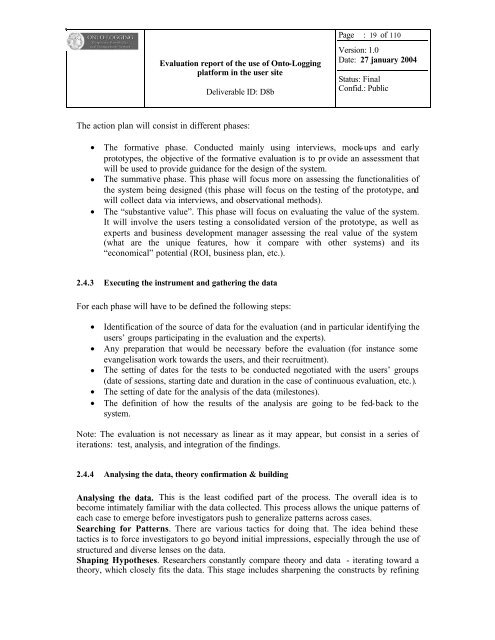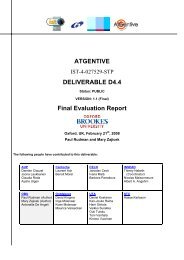pdf 820Kb - INSEAD CALT
pdf 820Kb - INSEAD CALT
pdf 820Kb - INSEAD CALT
Create successful ePaper yourself
Turn your PDF publications into a flip-book with our unique Google optimized e-Paper software.
Evaluation report of the use of Onto-Logging<br />
platform in the user site<br />
Deliverable ID: D8b<br />
The action plan will consist in different phases:<br />
Page : 19 of 110<br />
Version: 1.0<br />
Date: 27 january 2004<br />
Status: Final<br />
Confid.: Public<br />
• The formative phase. Conducted mainly using interviews, mock-ups and early<br />
prototypes, the objective of the formative evaluation is to pr ovide an assessment that<br />
will be used to provide guidance for the design of the system.<br />
• The summative phase. This phase will focus more on assessing the functionalities of<br />
the system being designed (this phase will focus on the testing of the prototype, and<br />
will collect data via interviews, and observational methods).<br />
• The “substantive value”. This phase will focus on evaluating the value of the system.<br />
It will involve the users testing a consolidated version of the prototype, as well as<br />
experts and business development manager assessing the real value of the system<br />
(what are the unique features, how it compare with other systems) and its<br />
“economical” potential (ROI, business plan, etc.).<br />
2.4.3 Executing the instrument and gathering the data<br />
For each phase will have to be defined the following steps:<br />
• Identification of the source of data for the evaluation (and in particular identifying the<br />
users’ groups participating in the evaluation and the experts).<br />
• Any preparation that would be necessary before the evaluation (for instance some<br />
evangelisation work towards the users, and their recruitment).<br />
• The setting of dates for the tests to be conducted negotiated with the users’ groups<br />
(date of sessions, starting date and duration in the case of continuous evaluation, etc.).<br />
• The setting of date for the analysis of the data (milestones).<br />
• The definition of how the results of the analysis are going to be fed-back to the<br />
system.<br />
Note: The evaluation is not necessary as linear as it may appear, but consist in a series of<br />
iterations: test, analysis, and integration of the findings.<br />
2.4.4 Analysing the data, theory confirmation & building<br />
Analysing the data. This is the least codified part of the process. The overall idea is to<br />
become intimately familiar with the data collected. This process allows the unique patterns of<br />
each case to emerge before investigators push to generalize patterns across cases.<br />
Searching for Patterns. There are various tactics for doing that. The idea behind these<br />
tactics is to force investigators to go beyond initial impressions, especially through the use of<br />
structured and diverse lenses on the data.<br />
Shaping Hypotheses. Researchers constantly compare theory and data - iterating toward a<br />
theory, which closely fits the data. This stage includes sharpening the constructs by refining
















